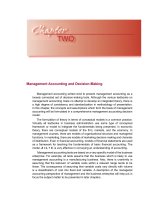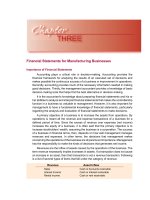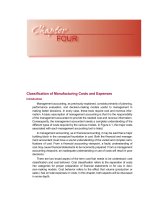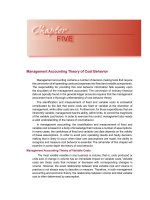Nen Tang Cua Ke Toan Quan Tri Chaper 3
Bạn đang xem bản rút gọn của tài liệu. Xem và tải ngay bản đầy đủ của tài liệu tại đây (518.28 KB, 20 trang )
Management Accounting
| 31
Financial Statements for Manufacturing Businesses
Importance of Financial Statements
Accounting plays a critical role in decision-making. Accounting provides the
nancial framework for analyzing the results of an executed set of decisions and
makes possible the continuous success of a business or improvement in operations.
Secondly, accounting provides much of the necessary information needed in making
good decisions. Thirdly, the management accountant provides a knowledge of basic
decision-making tools that helps nd the best alternative in decision-making.
It is the accountant’s knowledge about preparing nancial statements and his or
her abilities to analyze and interpret nancial statements that makes the controllership
function in a business so valuable to management. However, it is also important for
management to have a fundamental knowledge of nancial statements, particularly
regarding the analysis and evaluation of nancial statements to make decisions.
A primary objective of a business is to increase the assets from operations. By
operations is meant all the revenue and expense transactions of a business for a
dened period of time. Since the excess of revenue over expenses (net income)
increases the equity of a business, it is often said that the primary objective is to
increase stockholders’ wealth, assuming the business is a corporation. The success
of a business in nancial terms, then, depends on how well management manages
revenues and expenses. In other terms, the decisions that management makes
concerning the operations of the business are of paramount importance. Management
has the responsibility to make the kinds of decisions that generates net income.
Revenues are the inow of assets caused by the operations of the business. The
term revenue necessarily implies increases in assets. If a transaction does not cause
an increase in an asset, then that transaction is not a revenue transaction. Following
is a list of several types of items that fall under the category of revenue:
Revenue Asset Inow
Sales Cash or Accounts receivable
Interest Income Cash or interest receivable
Rental income Cash or rent receivable
32 |
CHAPTER THREE
•
Financial Statements for Manufacturing Business
Expenses are the outow of assets from the operations of the business. Expenses
are caused by activities necessary to generate revenue. When revenues exceeds
expenses as is the goal, the difference is called net income. If a transaction does not
cause a decrease in an asset, then that transactions is not an expense. Following
is a list of several expenses and the asset decrease associated with that particular
expense.
Expense Asset outow
Cost of goods sold Prepaid insurance
Salaries Expired life of the service value
Supplies expense Supplies
Depreciation, building Expired cost of a building
Technically, the asset outow associated with salaries is not cash. Payments are
made to workers and other employees because they create something of value. In
more technical terms an expense is the expired value of an asset. A janitor is paid
to clean oors. The thing of value acquired is a clean oor and as long as the oor
remains clean, it is something of value. However, when the clean oor becomes dirty
again, then the value of the clean oor asset has expired. Because many assets have
a very short life, the accountant often simply records the expense even though the
value of the assets at the time of recording has not yet expired.
Often the acquisition of an asset is not paid for immediately and the amount then
owed is called a liability. Liabilities are debts or obligations to pay at some future date
and are a common form of nancing in a business. There are three primary sources
of assets in a business: (1) revenues (2) liabilities (3) capital. The ve key words
from an accounting viewpoint and also from a management viewpoint are assets,
liabilities, capital, revenue, and expenses.
In one sense, the purpose of management is to make asset, liabilities, capital,
revenue, and expense decisions. Since the income statement shows revenues,
expenses and net income and the balance sheet shows assets, liabilities, and capital,
we can say that the purpose of management is to manage assets, liabilities, capital,
revenue, and expenses. Stated simply, the purpose of management is to manage
nancial statements.
Because of the importance of sound operations and nancial condition, it is criti-
cally important for both management and accountants to have a sold understanding
of nancial statements. While accountants prepare nancial statements, it is manage-
ment that creates nancial statements through the decisions it makes. Because of
the importance of nancial statements, the rest of this chapter is concerned with
presenting the fundamentals of nancial statements for a manufacturing business.
The four nancial statements of critical value in this text are as follows:
1. Balance sheet
2. Income statement
3. Cost of goods manufactured statement
4. Statement of cash ow
Management Accounting
| 33
Financial statements are based on well dened accounting concepts and
standards, some of which are fairly technical and require some concentrated study to
learn and use. The following is a list of accounting terminology and concepts important
in understanding nancial statements for a manufacturing business.
Accounting Terminology
Amortization
Accounts receivable
Accounts payable
Bonds
Bad debts
Credit
Capital
Cash
Common stock
Contribution margin
Cost
Current assets
Cost of goods sold
Cost of goods manufactured
Depreciation
Direct cost
Dividends
Finished goods
Fixed assets
Factory labor
Fixed cost
Gain/loss on sale
Gross prot
Indirect cost
Inventory
Income taxes
Investment
Manufacturing overhead
Material used
Net income
Net operating income
Net income after taxes
Perpetual inventory
Periodic inventory
Retained earnings
Premium/discount on stock
Premium/discount on bonds
Stockholders’ equity
Tax expense
Treasury stock
Trade-in value
Variable cost
Hopefully, you have learned these terms in a previous accounting course and
only some review of these terms is needed.
In addition to terminology, there are some accounting concepts and conventions
of a broader nature that involve theory and even, in some cases, considerable
differences of opinion. Some of the important concepts involved in this book are
shown as follows.
Accounting Concepts
Absorption costing Earned/unearned revenue
Accrual basis accounting Inventory costing methods
Accounting control Matching
Cash basis accounting Planning
Cost Standards/principles of accounting
Control Full costing reporting
Deferred charges Contribution basis reporting
Direct costing
Accounting Financial Statement Relationships
In addition to important nancial statement terminology, there are a number of
manufacturing nancial statement relationships critical to understanding and using
nancial statements. These relationships may be summarized as simple mathematical
equations. The most important of these relationships are the following:
34 |
CHAPTER THREE
•
Financial Statements for Manufacturing Business
Cost of Goods Manufactured Statement
Material used = materials (beginning) + material purchases - materials inventory
(ending)
Cost of goods manufactured = materials used + factory labor + manufacturing
overhead + work in process (beginning) - work in process (ending)
Income statement
Cost of goods sold = nished goods (beginning) + cost of goods manufactured
- nished goods (ending)
Finished goods (beginning) plus cost of goods manufactured is often called
goods available for sale.
Net income = sales - cost of goods sold - operating expenses
The difference between sales and cost of goods sold is often reported as gross
prot.
Balance Sheet
Assets = liabilities + stockholders’ equity
Assets = current assets + xed assets + other assets
Liabilities = current liabilities + long-term liabilities
Stockholders’ equity = common stock + premium/discount on common stock +
retained earnings
Statement of Cash Flow
Change in cash = sources and uses from operations + sources and uses from
nancing activities + sources and uses from investing activities.
While the above equations may seem a bit complex and imposing, these
relationships still, nevertheless, form the foundation of nancial statements for
a manufacturing company. Since it is critical that managerial decision-makers
understand and use nancial statement information, it is essential that the serious
student of management understand these basic nancial statement relationships.
A complete set of nancial statements for the last period of operations may be
found in chapter 9 of The Management/Accounting Simulation. However, often a
summarized version is easier understand and use for some purposes. Therefore, a
summarized version of the nancial statements for the V. K. Gadget Company is now
presented in Figure 3.1.
Analyzing Financial Statements
Understanding nancial statements is only the rst step in using them. The second
step is to analyze them in order to discover any existing or potential problem areas of
prot performance or nancial conditions that needs corrective action. Several tools
exist that may be used including the following:
1. Comparative statements
2. Financial statement ratios
Management Accounting
| 35
V. K. Gadget Company
Cost of Goods Manufactured Statement
For the 4
th
Quarter, Year 1
Materials Inventory (B) $1,940,160
Material Purchases 4,892,160
_________
6,832,320
Materials Inventory (E) 2,065,114
_________
Material used 4,767,206
Factory labor 2,787,840
Manufacturing Overhead (V) 323,424
_________
$7,878,470
_________
_________
Units manufactured 57,027
Cost per unit $138.16
_________
_________
V. K. Gadget Company
Income Statement
For the 4
th
quarter, Year 1
Sales $17,123,428
Cost of goods sold 7,878,470
–––––––––
Gross prot 9,244,958
Expenses
Selling 8,733,425
General and Admin. 924,313
Fixed mfg. overhead 1,889,574
–––––––––
Total expenses 11,547,312
–––––––––
Net operating income (2,302,354)
Other income & expenses 112,500)
Income taxes (965,941)
–––––––––
Net loss ($1,448,912)
–––––––––
–––––––––
Figure 3.1 • Financial Statements
V. K. Gadget Company
Balance Sheet
Dec. 31, year 1
Assets
Current Assets $3,731,277
Fixed assets 6,400,000
Other assets -0-
––––––––––
Total Assets $10,131,277
––––––––––
––––––––––
Liabilities
Current liabilities 5,630,523
Long-term -0-
––––––––––
Total liabilities $5,630,523
––––––––––
Stockholders’ Equity
Common stock $6,000,000
Premium on common stock 1,000,000
Retained earning (2,499,246)
––––––––––
Total stockholders’ equity $4,500,754
––––––––––
Total liabilities and equity $10,131,277
––––––––––
––––––––––
V. K. Gadget Company
Statement of Cash Flow
For the quarter Ended, Dec. 31, year 1
Cash ow from Operating Activities
Sources $ 17,123,428
Uses 17,123,428
––––––––––
Excess of uses over sources -0-
Cash ow from Investing activities
Sources -0-
Uses -0-
––––––––––
-0-
Cash ow from nancing activities
Sources -0-
Uses -0-
––––––––––
-0-
––––––––––
Net decrease in cash $ -0-
––––––––––
––––––––––
36 |
CHAPTER THREE
•
Financial Statements for Manufacturing Business
The use of ratios is a commonly used method to determine conditions that might
be a current or future problem. The current ratio can be computed to determine if
current assets are sufcient to make payments of current liabilities. The debt/equity
ratio is a good indicator of whether the company is too heavily burdened with debt.
The prot margin percentage is a good measure of the adequacy of net income to
sales. The computation of the return on investment ratio is an excellent benchmark
for determining whether net income is satisfactory or unsatisfactory. Numerous other
ratios may be computed and most elementary accounting textbooks do an excellent
job of discussing the more important ratios. A detailed discussion of ratios is presented
in chapter 17.
Financial Statements: A Model of Decision-making
Also, nancial statements may be used as a guide to identifying what nancial
statements elements are directly affected by a specic decision. This approach is not
commonly used, but because it is helpful in understanding how decisions affect the
various items of nancial statements, it is discussed here now in some detail. For
example, every item on the balance sheet such as accounts receivable or inventory
is the result of the execution of one or more identiable decision. It is management’s
primary responsibility to manage each element of a given nancial statement. Financial
statements, in one sense, are a check list of what management is to manage. This
approach states rather explicitly, as previously discussed, that a primary purpose of
management is to manage assets, liabilities, capital, revenue, and expenses.
To clarify the above statements, the following nancial statements of the V. K.
Gadget Company are presented in terms of decisions and required information.
Cost of Goods Manufactured Statement
Cost Element Decision(s)
Information
Required
Material
Direct labor (variable)
Manufacturing overhead
Supplier A, B, C, or D
Order size, material X
Number of orders, material X
Order size, material Y
Number of orders, material Y
Number of factory workers
Wage rate
Budgeted production
Type of nishing department
equipment
Order size of material
Factory labor compensation
List prices
Quantity discounts
Carrying cost
Cost of placing an order
Units of equipment
Wage rate function
Production budget
Capacity required
Carrying cost of inventory
Overhead rate
Variable cost rates
Salaries, supervisors
Figure 3.2 •
Management Accounting
| 37
These nancial statement models presented in terms of decisions and required
information rather than actual values clearly indicate an important point. It is
management rather than accountants that actually creates nancial statements. The
nancial well being of the company’s operations is clearly the full responsibility of
management.
Accounting Policies and Procedures
While the operating and nancial success of a company falls squarely on the
shoulders of management, there is still considerable latitude on the part of accountants
in preparing nancial statements. Any accounting system involves rules, standards,
and procedures that can vary
from company to company. The overall guiding principle
Income Statement
Item Decisions Information Required
Sales
Cost of goods sold
Expenses
Advertising
Sales people
compensation
Credit expense
Depreciation
Bad debts
Interest expense
Price
Credit terms
Advertising
Commission rate
No. of sales people
Sales people salary
Same as cost of goods
manufactured (see above)
Sales decisions (see above)
Advertising budget
Number of sales people
Commission rate
Sales people salaries
Credit terms
Units of equipment and
nishing
Department equipment
replacement
Credit terms
Bank loans
Issue of bonds
Line of credit
Demand schedule
Sales-calls function
Advertising rates
Commission rate function
Calls per quarter
Same as cost of goods
manufactured and sales
decisions
Advertising cost
Demand curve
Sales people compensation
function
Credit terms function
Credit department expenses
Operating costs
Depreciation rates
Credit terms function
Interest rate
Cost of capital
Discount rate
Figure 3.3 •
38 |
CHAPTER THREE
•
Financial Statements for Manufacturing Business
is that once rules, standards, and procedures have been adopted, they should be
consistently applied. In the V. K. Gadget Company, the following procedures and
methods have been adopted.
Figure 3.4 •
Accounting Policies and Procedures
Item Procedure
Material costing method Average costing
Finished goods costing method Average costing
Bad debt method Percentages of sales method
Depreciation of equipment Straight-line
Income format Segmental income statement
Manufacturing overhead costing
method
Direct costing (variable costing)
Treatment of common expenses Allocation by sales orders
Income taxes Net income is shown net of taxes
Bond discount Scientic amortization method
Management Accounting Systems
In addition to understanding and utilizing nancial statements and nancial
accounting tools, it is important that both accountants and management have a good
understanding of management accounting concepts and tools. One of the most
effective tools is comprehensive business budgeting. The objective of comprehensive
budgeting is to prepare a set of nancial statements in advance. The end result of the
budgeting process is a planned set of nancial statements. A comprehensive budgeting
system for the V. K. Gadget company, the simulated company in The Management/
Accounting Simulation, has been developed and is ready for use. Whether or not
this system should be used is a decision that you would make, assuming you are a
participant in the simulation, and serving in the role of new management. In addition
to the comprehensive budget, other computerized management accounting tools are
available for use. These tools include:
1. Business budgeting
2. Cost behavior
3. Cost-volume-prot analysis
4. Capital budgeting analysis
5. Credit analysis
6. Demand sensitivity analysis
7. Direct costing analysis (variable costing)









